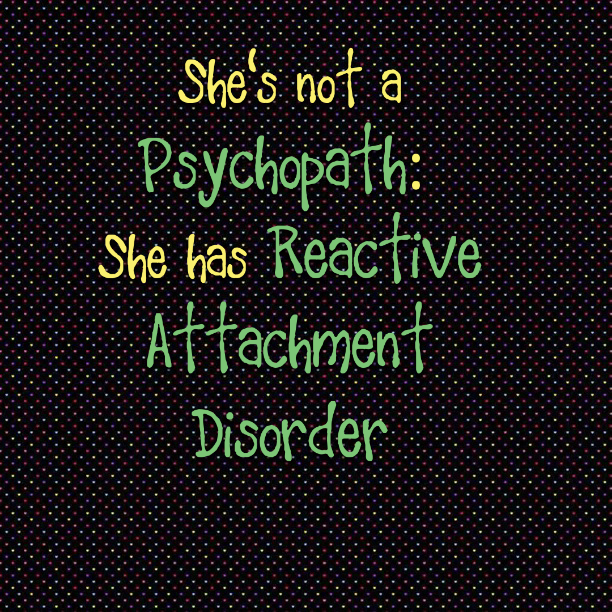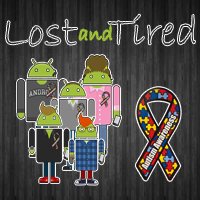Heather reached out to me on Facebook and wanted to share this article she wrote for the Examiner. It’s about her personal experience with her niece who has Reactive Attachment Disorder. There are a great many similarities to Gavin, although Gavin is a bit different and is considered a Sociopath already. Officially, he’s considered diagnosed with Reactive Attachment Disorder until he turns 18.

This is Heather’s story and it really helps to explain what families like ours go though…… I want to thank Heather for reaching out and sharing her story. Below is her original article and links to her post on The Examiner.
She’s not a Psychopath: She has Reactive Attachment Disorder
RayRay circa 2009
My niece, who was a foster child when she was eight years old, tried to drown her foster brother as they swam in the backyard pool. The boy was saved by his siblings shouting to the foster mom, who came and rescued him. This was a typical event. The girl showed no empathy or remorse. She really wanted him dead because he had splashed her accidentally as he swam by.
RayRay*, my niece, is the same girl that I invited into my home when she was just about to turn 15. What was I thinking? How will I help this girl? What is in store for her future? What medical attention does she need and can I afford it? All these questions I failed to ask before RayRay moved in because I wanted to “fix” her disorders and help her lead a happy, productive life.
In the simplest terms, a child with Reactive Attachment Disorder (RAD) is one who is unable to form an attachment with a caretaker and consequentially not with anyone else except on the most superficial levels. “I troubled teenage[r] suffering from RAD may be characterized by a lack of affection for one’s family.” (TroubledTeensInfo, 2007).
In order to understand an attachment disorder, one must know what a healthy attachment cycle is. When an infant has a need, the baby cries. Upon hearing the cries, the mom (or other primary caregiver) fulfills the need. The baby learns to trust that person to take care of him or her. In the second year secure attachment cycle process, the child expresses a desire, the caretaker sets the limits, boundaries, or says “no.” The child will then either accept the limit or test and defy the limit. The caregiver responds appropriately to this (rewarding for acceptance of limit; consequences for defiance). This allows the child to develop the ability to accept the caretaker’s “control” and limits placed on him or her. It is also how the child develops the sense this person is here to protect him or her from harm.
So what causes RAD? If certain events occur during the two cycles (first three years of a child’s life) to inhibit the trust and security process, the child has a higher risk of developing an attachment disorder. This does not mean the child will always develop a disorder, but that the child is at an increased risk.
The events that could interrupt the cycles include anything that prevents the primary caretaker from performing his or her job in the cycle, such as physical abuse, neglect, abandonment, changes in primary caretakers (rapid and frequent changes in daycare providers) child or parent’s illness or hospitalization.
Another possible cause could be a lack of parental skills (such as found with teenage parents). The oft-repeated phrase “Children don’t come with a manual,” while true, may lead some parents to believe that they should just wing it. While one should trust his or her gut, there are resources out there than can help a parent understand child development, in particular how the infant’s brain reacts during the attachment cycles. This is especially necessary in cases of adoption.
But what happens when this child, as she grows older, has not been healed? The prognosis for any disorder is improved with early detection and treatment. In RayRay’s case, she was seven years old when she was placed with that foster mother, Mr. R*. Ms. R battled with RayRay for five long years (including a year spent in a therapeutic foster mom) before having to send RayRay back to her biological mom. RayRay spent one and a half years with her biological mom. During this time parentification (where the child acts as the parent) developed, leaving RayRay to feel as though she was the “adult” of the house. This is a common problem for children with RAD. They seek to be in charge because inside they do not feel they can trust another to take care of his or her needs. The damage was done by that point.
This was confirmed by the birth mom who did not understand what parentification would to do RayRay in her RAD; Mom thought she was giving RayRay what she wanted/needed. We all give our children doses of independence as they grow and by this time RayRay was a teenager (chronologically speaking). In reality, while RayRay may have fought her mom to be able to do chores, make supper, get the other children ready for bed or school, what she psychologically wanted was her Mom to do these things and to be able to trust her mom to do them. However, RayRay couldn’t let go of the control to give her mom that chance. Education about this disorder is critical to he healing process.
The problem at the core for RAD children is an inability to trust a caretaker to love them and provide for their needs. This is deeply rooted in their brains and takes a lot of hard work to heal from. Unfortunately, the time spend with her biological mother undid the majority of healing that RayRay had done with her foster mom because of the change of caretakers.
When RayRay moved in with me, I began seeing the RAD symptoms and behaviors right away. I began to fullyunderstand what this diagnosis mans for her and my family. I could go on and on about the trials and tribulations we (as a family unit) lived through in those three years she was with me–but the most important thing to note is that these issues stem from “…a profound and pervasive disturbance in the child’s basic feelings of safety and security” (Kelly, 2003).
It was the hardest thing for me to understand that while these behaviors were targeted at me, it not about me. I was her target because I represented a threat to her. My loving heart represented death. To allow my love inside and to love in return requires trust. The last time this child trusted to care for her needs she was ignored and left to fend for herself.
Nance Thomas is a well-known expert on RAD and the commonly co-existing disorder in RADish children. For over twenty years she has been a therapeutic parent and shares her knowledge through books, seminars, and DVDs. However, in the intro of her book “When Love is Not Enough” she states: “The tools…are most effective with children from toddlers to the onset of puberty” (Thomas, 2005)> Does this mean there is no hope for teens and adults with RAD? No, there is a lot of hope, if the person wants to heal.
The teen years are when children typically start to learn independence as they should be. Teems need to learn how to attach properly before full independence, so again, their help is vital to the healing process. Sharing information with them about the disorder and how it impacts them and those around them should be encouraged. RayRay gets a kick out of seeing me research “her” on the INTERNET and through other sources. It helps her feel loved.
I’m fortunate that RayRay did have some early intervention. Her rages are now gone so her behaviors are more passive-aggressive which is safer, physically speaking. The passive-aggressive behaviors are more difficult to withstand from day to day sometimes as they are harder for other adults to see what is so “wrong” with how the children are acting. Everything is a battle for control.
Well-meaning doctors, teachers, social workers, and family members often do not understand that these behaviors are not just normal teenage behaviors. They often only see one side of the child (most typically the charming, friendly side) and so cannot get the full picture of what it is like to live with a RADish. Social workers should be aware that these children often file false charges of abuse–any means necessary to detach from someone who is “too close.” RayRay filed charges against a close family member accusing sexual assault. She has since recanted but the prosecution is going forward because they do not believe a child would make something up like this. There are reasons she had, and I could explain it here, but suffice it to say, it all boils down to her RAD.
In RayRay’s case, she tends to vilify prior caretakers to her current caretakers. There are two reasons for this: 1) to make it “OK” to leave them behind and 2) to garner sympathy as ammunition. She will often use this sympathy to get what she wants when I have told her no. She will use a very sad voice and say things like “Ohhh, I love that. I wish I could have one like it as I’ve never had one before…” which is typical of RADish children to do. Most times, friends, family members, and strangers will give RayRay what she wants because they feel sorry for her–never mind if I have said she can’t have it.
TroubledTeensInfo is the only website I was able to find that offered any advice regarding teens with RAD. The site suggests getting to the root cause of the RAD (such as parents going on a business trip). While this is definitely true, it surely is not enough!
Attachment therapy is more than just discussion of the past. The current caretaker and all family members should participate to show the child that she or he is worth it and she or he cannot manipulate and triangulate. A therapist must know that the right to privacy for these teens needs to be violated to some degree by always including the caretaker (at least for the first year). This will help keep the child “honest.” As mandated reporters, therapists are usually used by the RADishes to evoke drama and trauma. Even though a high amount of teens with RAD have a low-average IQ, they are very smart when it comes to games of manipulation.
The impact of having RAD in the home can be a troubling, stressful and harrowing experience. Caretakers need a lot of support. This can be done trying to find local respite caregivers, therapists, friends, family and support groups. Many times these resources are unavailable locally, but there are on-line support groups where the caregivers understand provide support. The members of these lists have been there too. Even if you’re not the primary caregiver, educating yourself on RAD is important to understanding and helping the parents heal these children.
* = names have changed to protect the people involved. Picture used with permission of RayRay who is now 18.



She may not be labelled a psychopath, but she sure does behave like one. I understand that RAD is horrible and that there is little to be done about it, but I have to be honest when I say that I would not want an RAD child in my house or near my children/pets.
The danger that can be presented by them is not a risk I’m willing to take.
I don’t think I would choose this if I had a choice. However, I don’t have a choice and that’s a big reason why life is so hard.
I’m so interested in this article — thank you for posting. There is a lot to learn from other parents and it’s wonderful people share.
One thing I’ve always questioned about the RAD literature, however, is the blame-the-mother mentality that pervades. I think because a lot of these kids have been in foster care, and the birth mothers are often problematic as care-givers, therapists and others have drawn a cause-and-effect link. The fact is that there is a constellation of similar diagnoses (BPD, sociopathy, etc) that share a lot of symptoms with RAD — and all have a strong genetic component.
Remember that we used to blame mothers for schizophrenia, cognitive delays, autism — the list goes on and on. So please take the mother-blaming with a grain of salt. The ability to form attachments to others occurs on a continuum just like height, the ability to run fast, anything else. Some kids are outliers.
Well said Dot. While some parents may be responsible, due to neglect or abuse, blaming the mother as a default is such an injustice and not accurate.